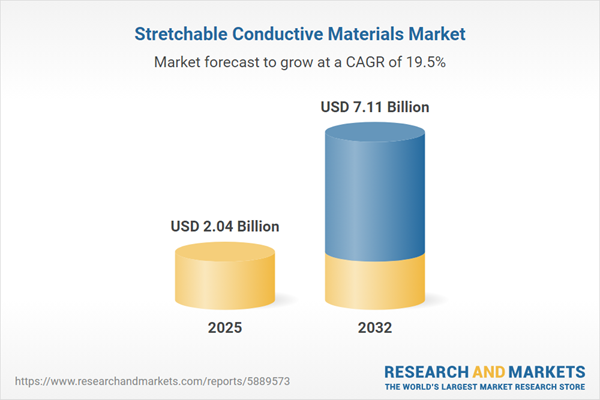Speak directly to the analyst to clarify any post sales queries you may have.
Stretchable conductive materials are reshaping how organizations approach innovation in flexible electronics, empowering senior decision-makers with adaptable product strategies and operational agility. This market provides avenues for operational efficiency, supports evolving design requirements, and positions businesses to respond effectively to shifting industry priorities.
Market Snapshot: Stretchable Conductive Materials Market
The global stretchable conductive materials market is valued at USD 1.71 billion in 2024, with projections indicating an increase to USD 2.04 billion by 2025. Continued momentum is expected to carry the market to USD 7.11 billion by 2032, representing a robust compound annual growth rate (CAGR) of 19.49%.
Market expansion is supported by rapid adoption across consumer electronics, healthcare, automotive, industrial automation, and robotics. Businesses are adapting their portfolios and workflows, emphasizing resilience and flexibility in response to evolving global dynamics. Early adopters of digitalization and supply chain agility stand at the forefront, advancing structural competitiveness through refined product development and operations.Scope & Segmentation: Key Areas in the Stretchable Conductive Materials Market
- Material Types: Carbon-based conductors, metallic conductors, conductive polymers, and liquid metals deliver diverse options. Each material supports use across sensitive wearable devices in healthcare as well as durable solutions for industrial automation.
- Form Factors: Coatings, fibers, films, and inks ensure seamless device integration, facilitating rapid product customization and development in both consumer and industrial sectors.
- End-Use Industries: Aerospace and defense, automotive, healthcare, consumer electronics, and wearables rely on these materials for enhanced device monitoring, improved interfaces, and progressive safety functionalities.
- Fabrication Technologies: Techniques such as dip coating, spin coating, spray coating, chemical and physical vapor deposition, gravure printing, inkjet, and screen printing provide scalable pathways for prototyping and commercial manufacturing to meet varying global demand.
- Geographic Regions: The Americas, Europe, Middle East & Africa, and Asia-Pacific each add unique value. Differences in mature supply infrastructure, leading R&D capabilities, and local innovation drive adoption and regional growth.
- Leading Companies Covered: DuPont de Nemours, 3M Company, Rogers Corporation, Covestro AG, Parker-Hannifin Corporation, Henkel AG & Co. KGaA, Avery Dennison Corporation, Avient Corporation, Nitto Denko Corporation, and Dow Inc. play pivotal roles in setting sector standards and steering advancements.
Key Takeaways for Senior Decision-Makers
- Integration of flexible circuitry strengthens operational reliability and boosts durability, serving critical business needs in dynamic sectors.
- Emerging carbon nanostructures and advanced polymers are expanding access to new adjacent applications, enabling differentiation and broader market reach.
- Strategic partnerships between manufacturers and research organizations are propelling research investments efficiently toward actionable, market-ready solutions.
- Implementing standardized manufacturing and supply chain processes effectively mitigates risks, supports regulatory compliance, and drives value across the supply chain.
- Developing region-specific strategies helps organizations align go-to-market tactics; for example, the Americas emphasize speed, Europe centers on sustainability initiatives, while Asia-Pacific builds on scalable production capacity.
Tariff Impact: Navigating Changes in Supply Chain Dynamics
New U.S. tariffs on metallic powders and specialty polymers are prompting shifts in sourcing strategies within the stretchable conductive materials market. Businesses are increasingly exploring alternatives such as carbon-based fillers and advanced conductive polymers. These changes foster more resilient supply chains and stable production flows, helping organizations respond to fluctuating global trade conditions.
Methodology & Data Sources
Analysis draws on a synthesis of technical literature, recent patent activity, and validated industry standards. Input from field experts and independent peer validation contribute to robust, actionable insights for senior leaders navigating the stretchable conductive materials market.
Why This Report Matters
- Equips research and procurement leads with reliable benchmarking to guide technology and resource planning as sector conditions evolve.
- Provides a clear view of market drivers and emerging trends, supporting organizations in fostering innovation and protecting asset value.
- Delivers concise, practical guidance to help executive teams address regulatory, technical, and operational changes, enabling effective transformation initiatives.
Conclusion
Adopting stretchable conductive materials empowers organizations to adjust product designs and operations with greater flexibility. This adaptable approach enhances readiness for industry change and supports lasting competitiveness in a rapidly transforming market landscape.
Additional Product Information:
- Purchase of this report includes 1 year online access with quarterly updates.
- This report can be updated on request. Please contact our Customer Experience team using the Ask a Question widget on our website.
Table of Contents
3. Executive Summary
4. Market Overview
7. Cumulative Impact of Artificial Intelligence 2025
Companies Mentioned
The companies profiled in this Stretchable Conductive Materials market report include:- DuPont de Nemours, Inc.
- 3M Company
- Rogers Corporation
- Covestro AG
- Parker-Hannifin Corporation
- Henkel AG & Co. KGaA
- Avery Dennison Corporation
- Avient Corporation
- Nitto Denko Corporation
- Dow Inc.
Table Information
| Report Attribute | Details |
|---|---|
| No. of Pages | 182 |
| Published | November 2025 |
| Forecast Period | 2025 - 2032 |
| Estimated Market Value ( USD | $ 2.04 Billion |
| Forecasted Market Value ( USD | $ 7.11 Billion |
| Compound Annual Growth Rate | 19.4% |
| Regions Covered | Global |
| No. of Companies Mentioned | 11 |









